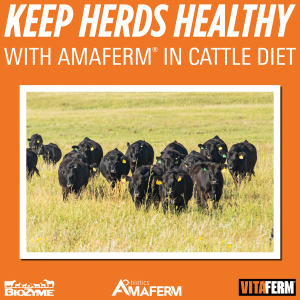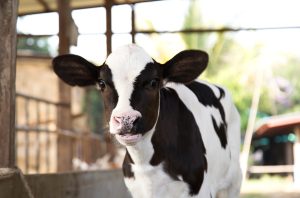
Winter is upon us, and for cattle producers, the wind and precipitation can make feeding cattle a challenge. Add the fact that most herds calve this time of year, meaning that cows’ nutritional needs are at their highest. Feeding cattle in winter can become a real chore!
Feeding cattle in winter is critical to management, especially in regions where forage quality declines significantly during colder months. Proper nutrition during this period ensures cattle health, productivity and reproductive performance. However, low-quality forage alone often cannot meet the nutritional demands of cattle during winter.
Cattle Nutrition Experts
VitaFerm® is an established brand of vitamin and mineral supplements designed to maximize energy and forage utilization for successful beef production. Our products support cattle producers looking to maximize their operations. Best of all, VitaFerm products ensure balanced nutrition for livestock.
Not only do we make and market nutritional supplements for livestock, but we also raise, breed and feed our herds. That is why sharing this information with fellow cattle producers is so important. It’s part of our care that comes full circle.
The VitaFerm brand is the flagship brand of BioZyme® Inc., a leading fermentation company pioneering advancements in animal nutrition and health. Through innovative research and high-quality manufacturing, BioZyme creates powerful solutions that improve animal performance and support producer profitability in the agricultural industry.
Our mission: undeniable positive impact on the health and wellness of your animals and your business.
Challenges of Feeding Cattle in Winter
Winter months mean challenges—everything from lower forage availability to reduced quality. Native pastures, crop residues and conserved forages such as hay are common feed sources during this time. However, their nutritional value often fades due to maturity at harvest, prolonged storage or exposure to adverse weather conditions.
Low-quality forage typically contains higher fiber content and lower concentrations of digestible nutrients such as protein and energy. This reduction impacts rumen function and limits the ability of cattle to extract nutrients. Forage with a crude protein content below 7% may not provide sufficient nitrogen for the rumen microbes to thrive. As a result, forage intake and digestion rates decrease, further compounding the nutrient deficit.
Tips to Optimize Feeding Cattle in Winter
Here are some essential tips to optimize winter cattle feeding:
Assess Forage Quality & Quantity
Test hay and silage for nutritional content, including protein, energy and mineral levels. Supplement poor-quality forage with grain, protein blocks or balanced feeds to meet the cattle’s dietary needs. At BioZyme, makers of VitaFerm, we offer our customers complimentary hay testing services so they know the nutritional value of their hay. Once our nutritionists receive the hay analysis, they can work with the producer to determine the best supplementation program.
Increase Energy & Protein
Cattle require more energy to maintain body temperature in cold weather. Provide higher-energy feed such as corn or other grains to ensure they maintain their body condition. Protein for cattle is essential for growth, reproduction and milk production. Include protein-rich feeds like alfalfa, soybean meal or commercial supplements if forage protein levels are insufficient.
Ensure Clean Water Availability
Dehydration can occur even in winter. Prevent water from freezing by using heated waterers or regularly breaking the ice. Water intake and appetite are directly correlated, and cattle consume less feed if water intake is inadequate.
Feed Consistently
Maintain a regular feeding schedule to support rumen health and digestion. Feed cattle during the warmest part of the day to minimize stress from cold temperatures.
Adjust Rations for Body Condition
Monitor the body condition of your cattle regularly. Thin animals may need additional feed to regain weight, while over-conditioned cattle should have adjusted rations to prevent metabolic issues.
Provide Shelter & Windbreaks
Protect cattle from harsh weather by providing shelter or windbreaks. Reduced exposure to cold winds decreases their energy requirements. If the ground is frozen or mud exists, consider bedding the ground with stalks or straw to give the cattle relief from wet or frozen ground.
Following these tips can keep your herd healthy and productive throughout the winter. Proper nutrition and care are key to maintaining herd performance and profitability.
VitaFerm Can Help
VitaFerm offers supplements ideal for feeding cattle through the winter and all seasons. AO-Biotics® Amaferm® is the key additive in all VitaFerm products. It has more than 150 published and/or presented research studies proving its increase in digestibility and, ultimately, its impact on the animal. Not only will you be supplementing your cows’ vitamin and mineral needs, but you will be providing them with Amaferm.
The key point of Amaferm is using it as a tool to get more energy metabolized by the cow. More forage digestibility leads to less physical fill—that means she can eat more. More VFA production provides the extra energy needed for thermoregulation, which will also help keep her warm in the cold winter months.
“Amaferm can help unlock the nutritional value of all types of forages. Amaferm goes beyond stimulating the growth of beneficial rumen bacteria and can also promote rumen fungal growth and enzymatic activity. This increases fiber digestibility and volatile fatty acid (VFA) production by 17% and 16%, respectively. As such, more energy becomes available to your cows, leading to more performance,” said Chris Cassady, Ph. D., BioZyme Beef Technical Sales Manager.
Amaferm also helps your feedstuffs and forages go further, helping decrease the overall cost.
“Research proves that cattle fed Amaferm synthesize 143 more grams of microbial protein each day. That’s enough protein equivalent to a pound of supplemented soybean meal available for the cow or heifer,” Cassady said. “Additional protein from Amaferm in a year-round supplemental program helps producers reduce the need for additional protein up to 40% annually, a huge continuous savings on feed costs.”
Providing supplements for your herd at critical times is an important part of feeding cattle in winter. At BioZyme, we give you options within the VitaFerm brand. Not sure what to feed cows when it comes to VitaFerm? Check out our Concept•Aid Product Navigator.
Get Your VitaFerm Today
Get your VitaFerm products from an authorized BioZyme dealer today. Our extensive dealer network is here to help you meet mineral needs.
Want to learn more about VitaFerm and our other products? Sign up for our electronic newsletter to stay in the know!


